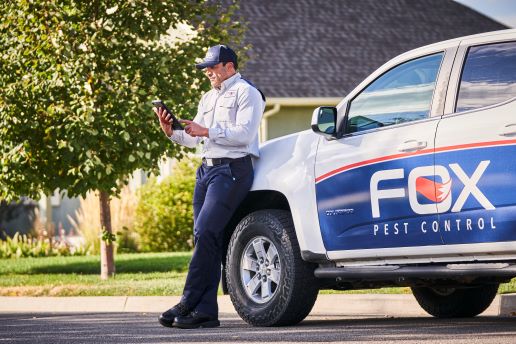Pest Control Marketing Budget Strategies (+Step-by-Step)

Your marketing efforts will be crucial to stand out and attract new customers.
With so many companies vying for attention, a well-thought-out marketing plan can be the difference between thriving and struggling. However, having limited budgets and competing with the big boys is challenging for small-to-medium-sized business owners.
That’s where a marketing budget comes in.
By allocating resources to the right channels, businesses can get the best return on investment (ROI) and make their marketing work for growth.
This guide will show you how to create a budget that works for your business, make informed decisions, and achieve your marketing goals.
Step 1. Understand Your Marketing Goals and Target Audience
Before you allocate your marketing budget, you need to have clear objectives.
Whether you want to increase leads, improve brand awareness, or target specific pest control services, defining your goals is the foundation of a good pest control marketing strategy.
To achieve those goals, you need to know your target audience.
Tailor your marketing to the right demographic, and your message will resonate and get higher conversion rates. Consider the following when identifying your audience:
Who are your potential customers? Homeowners, property managers, or businesses in your service area?
What pest control services do they need? Termite control, rodent removal, or general pest management?
Where do they spend time online? Social media, local directories, or search engines?
Knowing these factors and understanding user search queries lets you craft messages that speak directly to your target market.
For example, focusing on termite control in areas prone to infestations will attract homeowners who need your services. Knowing where your customers spend their time online helps you decide which digital channels to prioritize: local SEO, PPC campaigns, or social media advertising.
Understanding user search queries is crucial to effectively targeting content for different audiences. It is vital to use relevant keywords in your keyword research and content optimization for PPC campaigns. A researched and updated keyword list with industry-specific and high-volume keywords will make your advertising more visible and effective and improve search engine rankings.
Now you’ve defined your marketing goals and audience, it’s time to set a realistic marketing budget that matches your business objectives.
Step 2. Set a Realistic Marketing Budget
Industry benchmarks suggest that small—to medium-sized businesses should allocate between 7% and 10% of their revenue to marketing.
This percentage can vary depending on several factors.
Key factors influencing your marketing budget include:
Company size: Larger companies may need a bigger budget to maintain their market presence, and smaller businesses may start with a lower percentage.
Target market: If your service area is highly competitive, you may need to invest more in digital marketing, SEO, PPC, and paid search to stand out.
Growth goals: Aggressive growth plans may require a higher budget to fund big marketing campaigns across multiple channels. Effective PPC advertising is crucial in managing pay-per-click campaigns and ad visibility and performance.
Now that you have your budget, you can choose the proper marketing channels to maximize the results of your pest control business.
Step 3. Choose the Right Marketing Channels for Pest Control
There are several options in search engine marketing, each with its pros and cons depending on your budget, target audience, and desired outcomes.
Digital Marketing Channels:
SEO (Search Engine Optimization):
Pros: Increases online visibility and organic traffic.
Cons: Requires ongoing effort and time to see results.
PPC (Pay-Per-Click Advertising):
Pros: Instant visibility and measurable results. Google Ads is a popular PPC campaign platform with high traffic and visibility. Search engine marketing encompasses both SEO and PPC activities aimed at driving traffic through organic and paid search efforts.
Cons: PPC ads can be expensive, especially in competitive markets. Understanding the cost-benefit of PPC ads is key to budgeting.
Social Media Marketing:
Pros: Engages with potential customers and builds brand awareness.
Cons: Requires consistent content creation and management.
Traditional and Local Marketing Channels:
Local Advertising (Newspapers, Radio):
Pros: Targets a local audience directly.
Cons: Limited reach and often not measurable.
Community Outreach (Sponsorships, Events):
Pros: Builds local connections and trust.
Cons: It may not have immediate ROI and is time-consuming.
Now that you have evaluated these channels, you can create a marketing plan that matches your goals and budget.
Step 4. Craft a Winning Pest Control Marketing Plan
A plan outlines your strategies, tactics, timelines, and budget allocation so that all marketing activities work together to achieve your goals.
Key Components of a Marketing Plan:
Goals and Objectives: What do you want to achieve, whether it’s more leads, brand awareness, or expansion into new service areas?
Target Audience: Who is your ideal customer, demographics, needs, and behavior?
Marketing Strategies: Based on your audience and goals, choose the best marketing channels, such as SEO, PPC, social media, or email marketing. Remember that strong search engine rankings are vital in driving traffic to your website. Creating engaging and helpful content as part of a content marketing strategy is essential to improving visibility in search results.
Tactics and Actions: What specific actions will you take to implement each strategy, optimize your pest control website for local search, or launch a pay-per-click campaign for your service area?
Timeline: Set realistic deadlines for each action to keep your plan on track.
Budget Allocation: How much will you allocate to each channel and tactic?
Here’s a sample structure of a plan:
Executive Summary
Goals and Objectives
Target Audience Analysis
Marketing Strategies and Tactics
Timeline and Milestones
Budget Allocation
Metrics for Success
Now that you have a marketing plan, you can implement your strategies and track your progress so your pest control marketing is effective.
Step 5. Increase Your Marketing Budget’s Effectiveness with Digital Marketing Technology
Get more from your budget with FieldRoutes pest control software. This powerful tool simplifies your operations and amplifies your marketing so you can get better results with less.
Key Features of FieldRoutes:
Lead Management: Automatically capture and track leads so no opportunity is missed. Boost conversion rates and get more from your marketing budget.
Customer Communication: Engage and nurture customers with personalized and timely marketing messages. Automation helps you upsell, cross-sell, and retain customers to get more revenue with less effort.
Reporting and Analytics: Get valuable insights into customer behavior and campaign performance. Data-driven decisions help you refine your strategies and allocate your budget better.
FieldRoutes also integrates with ServiceTitan Marketing Pro, making creating and sending effective email and direct mail campaigns easy.
Businesses using this integration have seen up to 2.7x ROI on their marketing activity by sending multiple targeted campaigns.
Using automation and data-driven insights, you can get more from your marketing budget, grow your business, and increase profitability.
How Can You Determine Your Ideal Marketing Budget?
Determining the right budget is key to competing and achieving ROI from your pest control business. Follow this structured approach to create a budget that aligns with your business goals and growth.
Analyze Revenue & Industry Benchmarks
Review past revenue and industry data to get a baseline budget percentage. Pest control businesses typically allocate 7-10% of revenue to marketing, depending on their growth goals and market competition.
Define Clear Goals
Outline specific marketing objectives, such as generating more leads, increasing brand awareness, or entering new service areas. Clear goals will help you allocate your budget and marketing strategy.
Identify Your Target Audience
Understand your ideal customer, demographics, and behavior so you can target your marketing. Understanding user search queries is crucial to target content for different audiences effectively. Knowing your audience means investing in the right channels to reach your potential customers.
Research & Prioritize Channels
Research different marketing channels—search engine marketing (SEM) and social media—and calculate costs and ROI for your business. Optimizing your website for Google Search visibility is key to getting organic traffic.
Based on your target audience and goals, prioritize the channels that will give you the highest ROI. Search engine marketing encompasses SEO and PPC activities to drive traffic through organic and paid search efforts. Knowing what users are searching for can increase your site’s visibility and drive more targeted traffic.
Estimate Costs
Get quotes for marketing services and estimate the costs for each channel you choose. Knowing the costs will help you allocate your budget better.
Allocate Budget
Split your total marketing budget across your chosen channels, prioritizing the ones with the highest ROI. Make sure each channel has enough budget to achieve your marketing goals.
Track, Measure, and Adjust
Review your marketing performance and adjust your budget as needed. Continuous monitoring allows you to be agile and optimize your spending for better results.
Doing this allows you to create a marketing budget to grow your business and keep you competitive.
What Are Common Mistakes in Allocating a Pest Control Marketing Budget?
Allocating a marketing budget is pivotal to business growth, but many pest control companies make common mistakes that hinder their growth.
Underestimating Marketing: Treating marketing as an expense, not an investment, means underfunding and missing out on growth opportunities.
Focusing on One Channel: Relying on one marketing avenue limits your reach and customer base.
Ignoring Digital Marketing: Neglecting online channels like SEO, social media, and local SEO will leave you behind in today’s digital world.
Not Tracking Results: Not measuring ROI means you may waste resources on ineffective strategies without knowing what works. Several marketing tools can help you track the success of your marketing campaigns.
Not Adapting to Change: Sticking to old tactics means you won’t be able to capitalize on pest control industry trends. Keeping up to date with search engine algorithm changes is crucial for maintaining and improving search rankings.
Overspending on Ineffective Tactics: Allocating too much budget to channels that don’t resonate with your target audience will drain resources without delivering results.
Not Seeking Professional Help: Not seeking expert guidance means you’ll miss out on opportunities to optimize your budget and save time. If you do not have any marketing know-how, then seek a marketing agency to support your efforts. Make sure their pricing is affordable for you.
Lack of SEO Knowledge: Basic SEO knowledge is fundamental to avoiding common mistakes. Even a little SEO knowledge can significantly impact your website’s performance.
By avoiding these mistakes, you can create a more efficient marketing budget that grows your business and maximizes ROI.
What Metrics Should Be Tracked to Measure the Effectiveness of a Pest Control Marketing Budget?
Tracking the right metrics is crucial in measuring the effectiveness of your pest control marketing budget.
Website Traffic: Measure total visits, page views, and bounce rate to see how well your online presence attracts and engages potential customers.
Lead Generation: Track the number of inquiries, including phone calls, form submissions, and online chats, to see how well your marketing generates interest.
Lead Conversion Rate: Calculate the percentage of leads that convert to paying customers to see the quality of your leads and your sales process.
Customer Acquisition Cost (CAC): Calculate the average cost to acquire a new customer to determine the efficiency of your marketing spending.
Return on Investment (ROI): Compare revenue from marketing campaigns to your overall marketing spend to measure the effectiveness of your budget allocation.
Social Media Engagement: Monitor likes, shares, comments, and follower growth to see the impact and reach of your social media marketing.
Online Reviews: Keep an eye on positive customer reviews on platforms like Google and Yelp as they build credibility and attract new customers. Follow up with all positive and negative reviews. Contact good reviews and ask if they will give you a testimonial.
Customer Retention Rate: Track the percentage of customers who continue to use your services over time to measure customer satisfaction and loyalty.
Authoritative Sources: Follow authority sources like Search Engine Land for SEO resources, updates, and expert articles. This will inform you of the latest SEO, SEM, and PPC trends and best practices.
Monitoring these metrics regularly allows you to adjust your marketing strategies, maximize your budget, and grow your business.
It’s Your Turn Now
A pest control marketing budget is essential to business growth. Remember to set your goals, choose your marketing channels, and track your metrics. This will get you the most ROI and attract new customers.
FieldRoutes can help you with your marketing.
With lead management, customer communication, and detailed analytics, you’ll streamline your operations and make data-driven decisions. This will get you the most out of your marketing budget and grow your pest control business.
You can read more ways to automate your pest control business and boost your marketing strategy here.
Ready to take your marketing to the next level?
Schedule a free demo with FieldRoutes today and see how our software can transform your pest control business.





